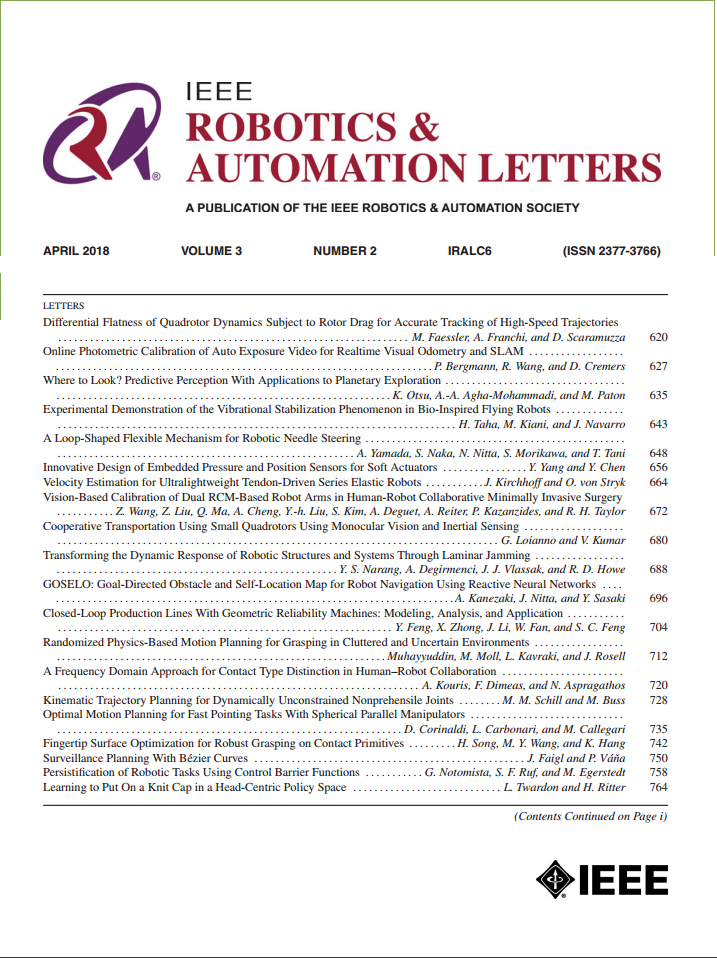基于rgb的基于深度恢复和自适应细化的类别级目标姿态估计
IF 4.6
2区 计算机科学
Q2 ROBOTICS
引用次数: 0
摘要
类别级姿态估计方法由于可以推广到类内未见物体,受到了广泛的关注。尽管基于rgb - d的分类级方法取得了重大进展,但对深度图像的依赖限制了实际应用。基于rgb的方法提供了一种更实用、更具成本效益的解决方案。然而,目前基于rgb的方法在物体几何感知方面存在问题,导致姿态估计不准确。我们提出了深度恢复和自适应细化从单个RGB图像的类别级目标姿态估计。我们利用DINOv2从输入的RGB图像中重建粗场景级深度,并提出了一种基于编码器-解码器架构的自适应细化网络,以动态改进预测的粗深度并减小其与地面真实值的差距。我们引入了2D - 3d一致性损失,以确保深度投影获得的点云与2D图像中的物体之间的对应关系。这种一致性监督使模型能够保持深度图像和点云之间的对齐。最后,我们从精炼的点云中提取特征,并将其输入到两个置信度感知的旋转回归分支和一个平移和大小预测残差分支中进行端到端训练。解耦旋转矩阵提供了更直接的表示,便于参数优化和梯度传播。在REAL275和CAMERA25数据集上的大量实验证明了该方法的优越性能。真实世界估计和机器人抓取实验证明了我们的模型对遮挡、杂波环境和低纹理物体的鲁棒性。我们的代码和机器人抓取视频可以在DA-Pose找到。本文章由计算机程序翻译,如有差异,请以英文原文为准。
RGB-Based Category-Level Object Pose Estimation via Depth Recovery and Adaptive Refinement
Category-level pose estimation methods have received widespread attention as they can be generalized to intra-class unseen objects. Although RGB-D-based category-level methods have made significant progress, reliance on depth image limits practical application. RGB-based methods offer a more practical and cost-effective solution. However, current RGB-based methods struggle with object geometry perception, leading to inaccurate pose estimation. We propose depth recovery and adaptive refinement for category-level object pose estimation from a single RGB image. We leverage DINOv2 to reconstruct the coarse scene-level depth from the input RGB image and propose an adaptive refinement network based on an encoder-decoder architecture to dynamically improve the predicted coarse depth and reduce its gap from the ground truth. We introduce a 2D–3D consistency loss to ensure correspondence between the point cloud obtained from depth projection and the objects in the 2D image. This consistency supervision enables the model to maintain alignment between the depth image and the point cloud. Finally, we extract features from the refined point cloud and feed them into two confidence-aware rotation regression branches and a translation and size prediction residual branch for end-to-end training. Decoupling the rotation matrix provides a more direct representation, which facilitates parameter optimization and gradient propagation. Extensive experiments on the REAL275 and CAMERA25 datasets demonstrate the superior performance of our method. Real-world estimation and robotic grasping experiments demonstrate our model robustness to occlusion, clutter environments, and low-textured objects. Our code and robotic grasping video are available at DA-Pose.
求助全文
通过发布文献求助,成功后即可免费获取论文全文。
去求助
来源期刊

IEEE Robotics and Automation Letters
Computer Science-Computer Science Applications
CiteScore
9.60
自引率
15.40%
发文量
1428
期刊介绍:
The scope of this journal is to publish peer-reviewed articles that provide a timely and concise account of innovative research ideas and application results, reporting significant theoretical findings and application case studies in areas of robotics and automation.
 求助内容:
求助内容: 应助结果提醒方式:
应助结果提醒方式:


